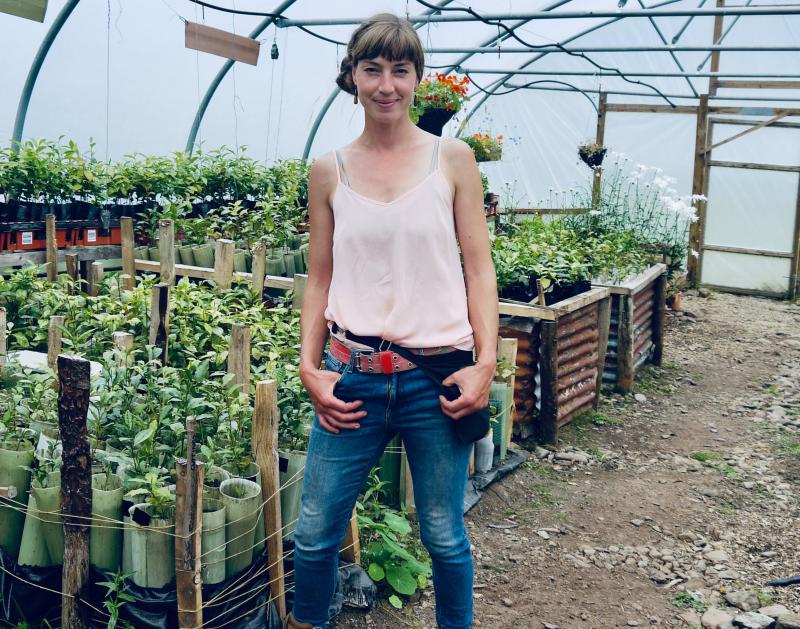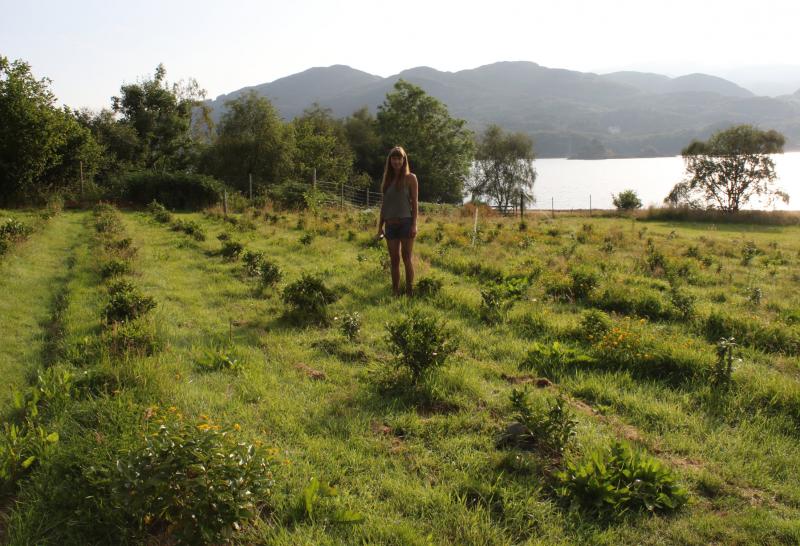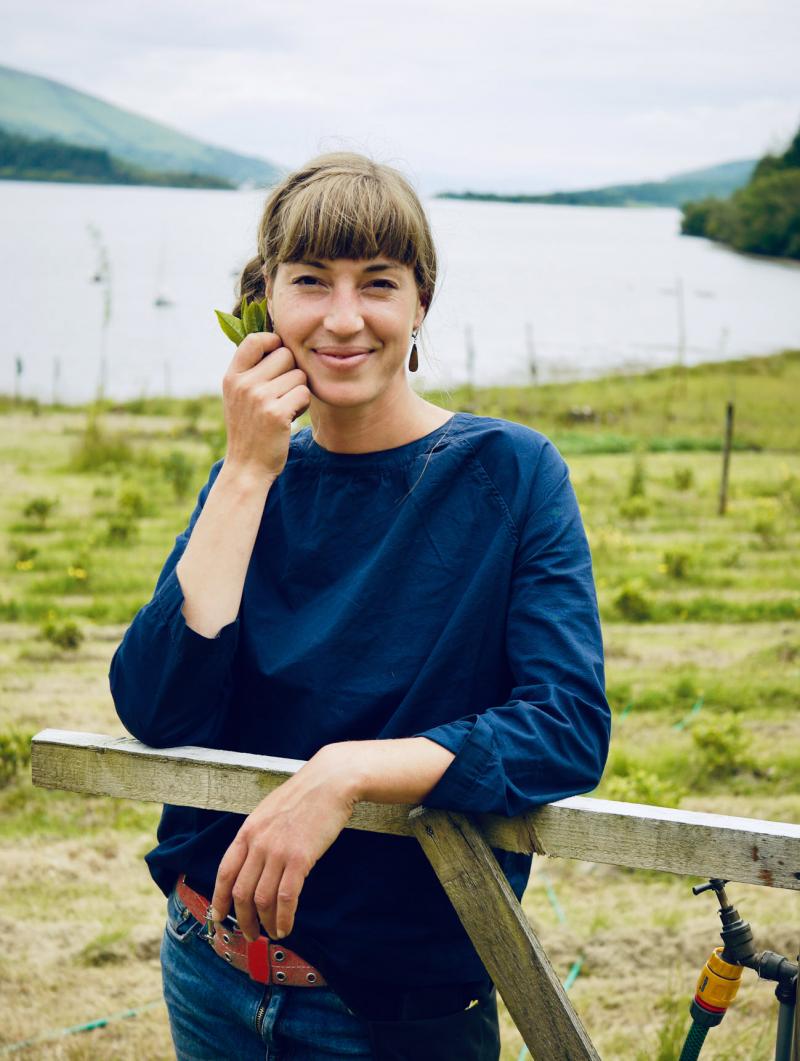Tea people are invariably passionate and intensely driven to produce something quite wonderful. This aptly describes Islay Roberts and Duncan Henderson, owners of Glen Caladh Farm in Scotland’s Cowal peninsula, who moved from their home in Edinburgh in late 2017 to pursue their organic endeavour.
Yet this canny couple have more: They are intensely practical with the nous to turn their combined skills to life on a 40-acre smallholding on the shore of a remote sea-loch, to their and the community’s advantage. Not many people could do this.
We spoke with Roberts to learn more about the project and what led the couple to Argyll and Bute in the west of Scotland.
The Desire to Live a More Sustainable Life
The couple first met when studying in Edinburgh – Roberts film and media with Spanish, and Henderson engineering. They worked and travelled before re-grouping in Edinburgh several years later. But by 2011, they were beginning to feel the pull of their rural roots, so began their search for a smallholding, where they could live a more sustainable life.

“We both grew up on farms,” explained Roberts. “Duncan had his own flock of sheep in Galloway when he was a teenager, and I used to bring up lambs and ducklings at my father’s organic vegetable and mixed animal farm on Orkney. I used to help him with whichever vegetable crop took my fancy that year. I’ve always been interested in food production as my parents were very good at self-sufficiency, so despite living in cities for most of my adult life, it has never felt right to eat from packets.”
Their early search focused on smallholdings in the east of Scotland, where the land is generally better suited to growing vegetables. Nothing felt quite right, however, and the slow realisation dawned that what they really wanted was the mountain, forest and seascapes of the west coast where they’d spent many happy holidays together. Glen Caladh Farm became available – they fell in love with it, bought it, and their path was set.
However, in an area better known for fishing, forestry and sheep farming, and where the high acid soils would not easily or optimally support growing arable crops or annuals, they had to re-jig their ideas.
“Attempts to farm crops in the most efficient way can negatively impact the environment,” remarked Roberts. “An area that might not naturally support that crop without considerable chemical inputs could eventually fail, but it's not just that crop that will fail, it is the natural ecosystem of that piece of land. I was taught to farm using organic methods, and the rules make a lot of sense to me as they have to consider the impact of that crop on the soil, flora and fauna. We depend on this environment too.”
They researched what would thrive naturally in the acid soils and microclimate of Glen Caladh farm, and preferably outdoors. “We didn’t want a farm covered in plastic tunnels; we wanted to plant a crop that was going to benefit from being grown outside,” said Roberts.

Unaware at that time of the rising number of pioneering tea growers across Scotland, the couple were surprised to come across a study by tea expert Nigel Melican looking at the feasibility of growing tea in Scotland. Commissioned by Tea Gardens of Scotland (a collective of nine growers in central Scotland) and funded by the Community Food Fund, the results were “overwhelmingly positive,” said Roberts. She added: “Perhaps a little too positive, it being a new cottage industry here with still young plants.”
Nevertheless, combined with their own research, tea began to look like a viable option when grown as a niche, high value crop, and conditions in the west bode well. Wetter, with 2000mm of average annual rainfall, and milder with less extreme weather than further east, as well as those favourably acidic soils, Argyll generally has many advantages for producing tea. The microclimate at the farm is also favourable – sheltered on three sides by forest and ancient woodland, meaning exposure to harsh winds, that can prove fatal or debilitating for the tea plant, is greatly reduced.
“The temperate rainforest in Argyll looks rather like the misty mountains of tea growing regions,” continued Roberts, half chuckling, as if any more inspiration were necessary. “The conditions here at Glen Caladh, with low hanging cloud at sea level, mimic the high growing tea regions in southeast Asia: Vietnam, Cambodia, Nuwara Eliya, Darjeeling, Nepal.”
The Young Plants Demand a Lot of Attention
Buoyed by excellent research and the help of a start-up grant from the Young Farmer and European Development Fund, the couple set-to. They erected a polytunnel and bought in 1,500 seedlings. They enclosed a three-acre pasture with deer fencing (deer being the most persistent of pests in the area), and in June 2018 planted out the seedlings over two acres.

Roberts has since experimented with cuttings from the healthiest plants, with more than 300 now thriving in the polytunnel for planting when hardened off, and more to follow. They also bought in a further 1,500 seedlings, to be overwintered in the tunnel and planted out next year. These will be interplanted with the current plants, to eventually create a double row and more traditional plucking table, according to Roberts.
In time, they will plant out the full three acres and, when money and more deer fencing permits, they will also create a more experimental biodiverse planting of native woodland interspersed with tea which will be allowed to grow more freely.
In the meantime, the young plants demand a lot of attention as they establish and before a yield of substance can be expected. A Glen Caladh single estate tea is the objective and will be developed over the coming harvests.
Leaves picked this year are being sent off to The Scottish Tea Factory in Comrie, Perthshire, to be processed. They will be combined with the pluck from other members of Tea Scotland – an association of growers established in 2015, which aims to support, discuss and educate one another in the fledgling industry. Roberts is current chair. There are around 20 members and, this year, 11 of the growers will contribute fresh leaf over the season to the group’s inaugural tea blend of authentic, Scottish-provenance tea, for release later this year.
Roberts believes it is important that the few leaves available in the short Scottish season are handled with expertise. She considers it incredibly good fortune to have access to Beverly Wainwright at the Scottish Tea Factory, where Beverly processes artisanal tea for growers using their own leaf.
“Beverly has been indispensable,” said Roberts. “She has many years of experience growing and processing tea and setting up micro tea factories from the ground up. What an amazing woman. We are lucky to be able to tap into this wonderful resource.”
Roberts added, “I think having the factory and the expertise in Scotland to make some truly wonderful teas is what will really elevate the quality of tea made here. The terroir is important, yes, but careful processing of leaf grown in microclimates like this is also critical. The experimentation of this processing method, to bring the best out of our leaf, is something we could not have done alone. Without enough leaf from slow-growing plants, every 100 grams is precious, and the best processing method needs to be found with the right hands until we all gain the experience and the knowledge that we need to do it ourselves.”
‘Championing Organic Tea in Scotland’
Roberts has also consulted with Monica Griesbaum of Windy Hollow Farm, Auchtertarder, Perthshire, whose natural farming philosophy aligns with her own. In an industry where the overarching advice is to use chemical inputs to grow a difficult crop, Monica provides a different viewpoint, said Roberts. “Monica is championing organic tea in Scotland. She does a lot of research into the soil and various methods of natural tea growing, from organic, biodynamic, natural and even wild teas. She has travelled extensively keeping her finger on the pulse with environmental issues facing the tea industry worldwide.”
Tea occupies most of Robert’s time for now, helped by Henderson when he’s not caught up with other activities. Whether that’s building a stile, converting an outhouse or installing a 23kw hydroelectric system to supply clean energy to the farm. “He’s an excellent mechanic, builder and problem-solver of impossible tasks,” said Roberts, and clearly just the chap when you live three miles off the beaten track on one of Scotland’s disarmingly beautiful sea lochs. More recently, the couple also managed to buy the village boatyard. Run by Henderson, it provides them with a useful alternative income stream and is also a vital service for the community.
Living the Good Life on Argyll’s Secret Coast
Meanwhile, it’ll be some years before the tea plants prove their worth, but there is never an idle moment living the good life on Argyll’s Secret Coast, as the area is known. Plans aplenty are in the pipeline: to build holiday cabins overlooking the water to attract tourists in the summer months; High Tea on the Sea, which Roberts will collaborate with other local producers on; and the removal of invasive Rhododendron ponticum – a common problem that will require a community-wide approach. That’s just the tip of the iceberg, but it seems very achievable for this dynamic duo, and something that the rest of us can only contemplate in our wildest of dreams.
It’s heart-warming and truly inspiring to meet a couple living their best lives, where they want to be, doing what they want to do in and in a conscientious manner.
Eunice Pallot is a tea and wine lover with a background in PR, marketing and journalism. She ran a tea import and tasting room in Jersey, Channel Islands, and is now writing, teaching tea classes and travelling, where possible. Visit her Instagram page for occasional updates. See Instagram.com/EuniceannPallot.
